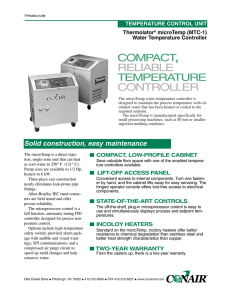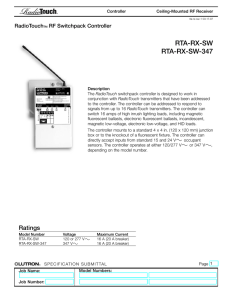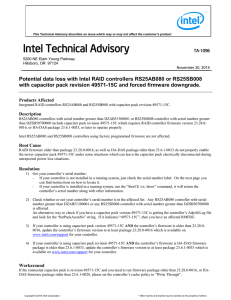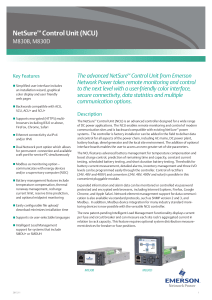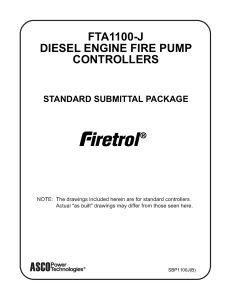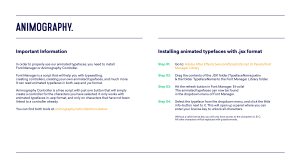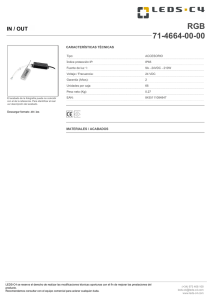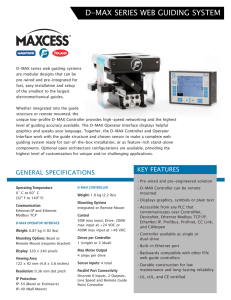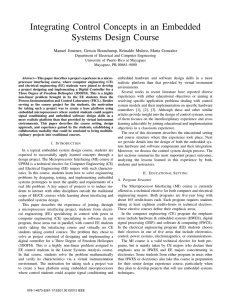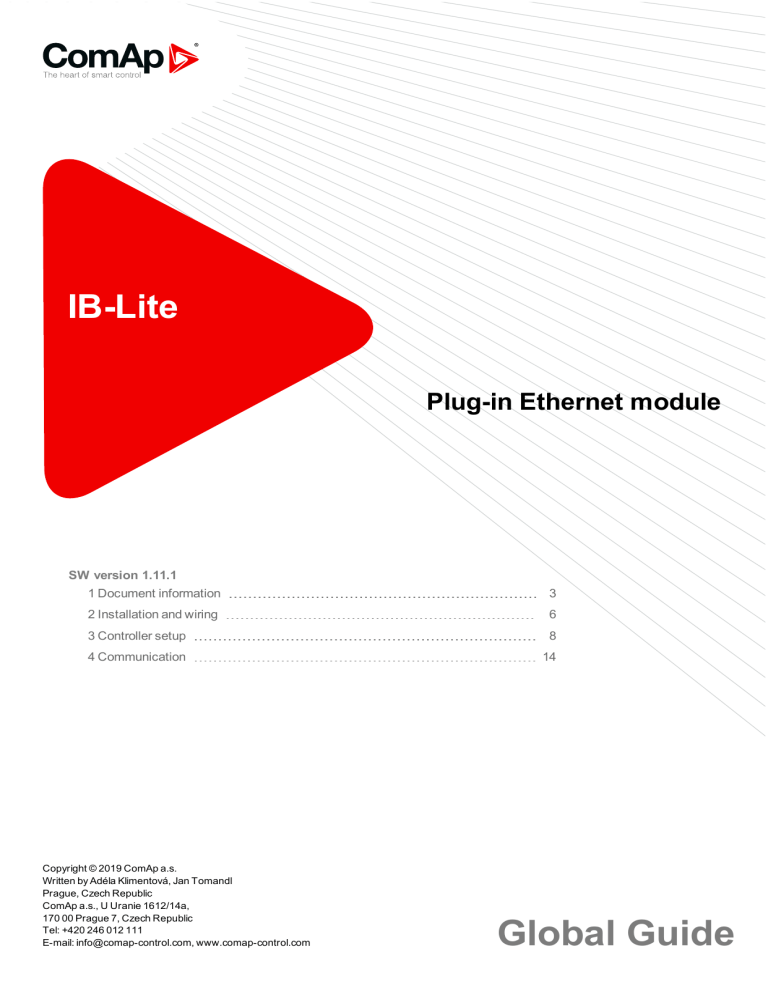
IB-Lite Plug-in Ethernet module SW version 1.11.1 1 Document information 3 2 Installation and wiring 6 3 Controller setup 8 4 Communication 14 Copyright © 2019 ComAp a.s. Written by Adéla Klimentová, Jan Tomandl Prague, Czech Republic ComAp a.s., U Uranie 1612/14a, 170 00 Prague 7, Czech Republic Tel: +420 246 012 111 E-mail: info@comap-control.com, www.comap-control.com Global Guide Table of contents 1 Document information 3 1.1 Clarification of notation 3 1.2 About this guide 3 1.3 Legal notice 3 1.4 Document history 5 2 Installation and wiring 6 3 Controller setup 8 3.1 Setup using controller setpoints 8 3.2 Setup using IB-Lite service web pages 9 3.3 Ethernet speed 11 3.4 Restore default settings 11 3.5 IB-Lite firmware upgrade 11 3.6 Custom logo upload 12 3.7 Other related controller adjustment 13 4 Communication 4.1 Network connection 14 14 4.1.1 Automatic configuration 14 4.1.2 Fixed configuration 14 4.2 Connection types 16 4.2.1 Direct connection using ComAp PC tools 16 4.2.2 AirGate connection using ComAp PC tools 17 4.2.3 MODBUS/TCP 17 4.2.4 SNMP 18 4.3 Web connection 19 4.3.1 Scada 19 4.3.2 Measurement 20 4.3.3 Setpoints 21 4.3.4 History 22 4.3.5 Web server adjustment 22 IB-Lite 1.11.1 Global Guide 2 1 Document information 1.1 Clarification of notation 3 1.2 About this guide 3 1.3 Legal notice 3 1.4 Document history 5 1.1 Clarification of notation Note: This type of paragraph calls readers attention to a notice or related theme. IMPORTANT: This type of paragraph highlights a procedure, adjustment etc., which can cause a damage or improper function of the equipment if not performed correctly and may not be clear at first sight. Example: This type of paragraph contains information that is used to illustrate how a specific function works. 1.2 About this guide IB-Lite is a plug-in communication module for controllers based on IL-NT, IC-NT and ID-Lite platform which provides Ethernet connectivity. Following protocols are available: ComAp proprietary protocol for Ethernet connection of ComAp PC programs such as LiteEdit and InteliMonitor. AirGate® support. SMTP protocol for sending of active emails from the controller. SMTP server authentification is supported. MODBUS/TCP protocol. SNMP v.1 Agent HTTP protocol for web-based monitoring and adjustment. Note: Changing of the controller configuration is possible only using LiteEdit. Note: Most of features listed above also require appropriate version of controller firmware, which supports the respective feature. Note: Since the version 1.10.0 there are new controller firmwares as e.g.InteliPro-1.5 now supported. 1.3 Legal notice This End User's Guide/Manual as part of the Documentation is an inseparable part of ComAp’s Product and may be used exclusively according to the conditions defined in the “END USER or Distributor LICENSE AGREEMENT CONDITIONS – COMAP CONTROL SYSTEMS SOFTWARE” (License Agreement) and/or in the “ComAp a.s. Global terms and conditions for sale of Products and provision of Services” (Terms) and/or in the “Standardní podmínky projektů komplexního řešení ke smlouvě o dílo, Standard Conditions for Supply of Complete Solutions” (Conditions) as applicable. IB-Lite 1.11.1 Global Guide 3 ComAp’s License Agreement is governed by the Czech Civil Code 89/2012 Col., by the Authorship Act 121/2000 Col., by international treaties and by other relevant legal documents regulating protection of the intellectual properties (TRIPS). The End User and/or ComAp’s Distributor shall only be permitted to use this End User's Guide/Manual with ComAp Control System Registered Products. The Documentation is not intended and applicable for any other purpose. Official version of the ComAp’s End User's Guide/Manual is the version published in English. ComAp reserves the right to update this End User's Guide/Manual at any time. ComAp does not assume any responsibility for its use outside of the scope of the Terms or the Conditions and the License Agreement. Licensed End User is entitled to make only necessary number of copies of the End User's Guide/Manual. Any translation of this End User's Guide/Manual without the prior written consent of ComAp is expressly prohibited! Even if the prior written consent from ComAp is acquired, ComAp does not take any responsibility for the content, trustworthiness and quality of any such translation. ComAp will deem a translation equal to this End User's Guide/Manual only if it agrees to verify such translation. The terms and conditions of such verification must be agreed in the written form and in advance. For more details relating to the Ownership, Extent of Permitted Reproductions Term of Use of the Documentation and to the Confidentiality rules please review and comply with the ComAp’s License Agreement, Terms and Conditions available on www.comap-control.com. Security Risk Disclaimer Pay attention to the following recommendations and measures to increase the level of security of ComAp products and services. Please note that possible cyber-attacks cannot be fully avoided by the below mentioned recommendations and set of measures already performed by ComAp, but by following them the cyber-attacks can be considerably reduced and thereby to reduce the risk of damage. ComAp does not take any responsibility for the actions of persons responsible for cyber-attacks, nor for any damage caused by the cyber-attack. However, ComAp is prepared to provide technical support to resolve problems arising from such actions, including but not limited to restoring settings prior to the cyber-attacks, backing up data, recommending other preventive measures against any further attacks. Warning: Some forms of technical support may be provided against payment. There is no legal or factual entitlement for technical services provided in connection to resolving problems arising from cyber-attack or other unauthorized accesses to ComAp's Products or Services. General security recommendations and set of measures 1. AccessCode • Change the AccessCode BEFORE the device is connected to a network. • Use a secure AccessCode – ideally a random string of 8 characters containing lowercase, uppercase letters and digits. • For each device use a different AccessCode. 2. Password • Change the password BEFORE the device enters a regular operation. • Do not leave displays or PC tools unattended if an user, especially administrator, is logged in. 3. Controller Web interface • The controller web interface at port TCP/80 is based on http, not https, and thus it is intended to be used only in closed private network infrastructures. • Avoid exposing the port TCP/80 to the public Internet. IB-Lite 1.11.1 Global Guide 4 4. MODBUS/TCP • The MODBUS/TCP protocol (port TCP/502) is an instrumentation protocol designed to exchange data between locally connected devices like sensors, I/O modules, controllers etc. From it’s nature it does not contain any kind of security – neither encryption nor authentication. Thus it is intended to be used only in closed private network infrastructures. • Avoid exposing the port TCP/502 to the public Internet. 5. SNMP • The SNMP protocol (port UDP/161) version 1,2 is not encrypted. Thus it is intended to be used only in closed private network infrastructures. • Avoid exposing the port UDP/161 to the public Internet. 1.4 Document history Revision number Related sw. version Date Author 18 1.11.1 11.09.2018 Adéla Klimentová, Jan Tomandl 17 1.11.0 21.09.2017 Adéla Klimentová, Jan Tomandl 16 1.10.1 16.3.2015 Adéla Klimentová, Jan Tomandl 15 1.10.0 8.1.2015 Adéla Klimentová, Jan Tomandl 14 1.9.0 9.12.2013 Adéla Klimentová, Jan Tomandl 13 1.8.1 14.6.2013 Adéla Klimentová, Jan Tomandl 12 1.8.0 30.11.2012 Adéla Klimentová, Jan Tomandl 11 1.7.1 3.8.2012 Adéla Klimentová, Jan Tomandl 10 1.7.0 1.3.2012 Adéla Klimentová, Jan Tomandl 9 1.6.0 30.3.2011 Adéla Klimentová, Jan Tomandl 8 1.5.2 2.3.2011 Adéla Klimentová, Jan Tomandl 7 1.5.1 22.2.2011 Adéla Klimentová, Jan Tomandl 6 1.5.0 3.2.2011 Adéla Klimentová, Jan Tomandl 5 1.4.0 24.2.2010 Adéla Klimentová, Jan Tomandl 4 1.3.0 8.12.2009 Adéla Klimentová, Jan Tomandl 3 1.2.0 16.11.2009 Adéla Klimentová, Jan Tomandl 2 1.1.0 6.10.2009 Adéla Klimentová, Jan Tomandl 1 1.0.0 19.12.2008 Jan Tomandl 6 back to Document information IB-Lite 1.11.1 Global Guide 5 2 Installation and wiring Disconnect the power source from the controller, remove the cover of the slot labeled "Communication module" located at the rear side of the controller and plug the module into the slot. IB-Lite 1.11.1 Global Guide 6 Note: The jumper described as "boot jumper" in previous versions of the documentation does not have any function. IB-Lite can not be used for "boot-jumper-programming" of a controller without valid firmware. 6 back to Table of contents IB-Lite 1.11.1 Global Guide 7 3 Controller setup Note: If the module is used with the latest versions of controller firmwares the basic setup is performed using setpoints in the controller. The setup using service web pages is used for additional settings. 3.1 Setup using controller setpoints 8 3.2 Setup using IB-Lite service web pages 9 3.3 Ethernet speed 11 3.4 Restore default settings 11 3.5 IB-Lite firmware upgrade 11 3.6 Custom logo upload 12 3.7 Other related controller adjustment 13 6 back to Table of contents 3.1 Setup using controller setpoints The latest versions of controller firmwares contain basic IB-Lite adjustments as setpoints in the group Comms settings. The IB-Lite module takes the settings from these setpoints. Fixed or automatic mode. In fixed (static) mode the adjusted IP address, network IP Addr Mode mask, gateway address and DNS server address are used. In automatic (dynamic) mode the DHCP protocol is used to obtain the previously mentioned settings from a DHCP server. The obtained settings are then copied into the respective setpoints. IP address of the module. In fixed mode this setpoint must be properly adjusted to fit IB-Lite IP Addr into the network, where the the module is connected. In automatic mode the setpoint contain the dynamically assigned address. Network mask. In fixed mode this setpoint must be properly adjusted according to the IB-Lite NetMask network, where the the module is connected. In automatic mode the setpoint contain the dynamically assigned value. IP address of the gateway which connects the network with the neighbourhood. In IB-Lite GateIP fixed mode this setpoint must be properly adjusted according to the network, where the the module is connected. In automatic mode the setpoint contain the dynamically assigned gateway address. This setpoint specifies the port number, which is used for communication using ComAp Port ComAp tools, both for direct and AirGate connections. Note: For AirGate connection use port 21 or 23. Enables AirGate connection. The direct TCP/IP connection can be used as well (IBLite-1.8 and above). AirGate Note: Some controller firmwares do not contain this setpoint and the AirGate mode is disabled if the setpoint AirGate IP is left blank. AirGate IP Address of the AirGate server. Either as domain name or as IP address. SMTP UserName User name for the SMTP account, which is used for sending active e-mails. If the IB-Lite 1.11.1 Global Guide 8 user name is left blank SMTP authentification is not used. SMTP UserPass SMTP ServerIP Password for the SMTP account. Address of the SMTP server (domain name or IP address) which is used for sending active e-mails. E-mail address, which is used as sender address in active e-mails that are sent from the controller. Contr MailBox Note: Most of public SMTP servers refuse sending e-mail if there is not an existing e-mail address in the "sender e-mail" field. TimeZone Time zone in which the controller is located. It is important for active e-mails to have proper "sent at" timestamp. IP address of the domain name server. In fixed mode this setpoint must be properly DNS IP Address adjusted to enable translation of domain names (including the domain name in e-mail addresses) to appropriate IP addresses. In automatic mode the setpoint contain the dynamically assigned DNS IP address. It is possible to adjust the setpoints using the front panel buttons, however it is more comfortable to use LiteEdit. Follow this procedure: 1. Switch the controller off, remove the IB-Lite module and install RS232 or USB module. 2. Switch the controller on and connect your PC with LiteEdit to the controller via the RS232 or USB. 3. Modify the configuration if needed and adjust all the necessary setpoints including the IB-Lite setpoints. Save the archive for backup purposes. 4. Disconnect the PC, switch the controller off, remove the RS232/USB module and reinstall back the IB-Lite module. 5. Connect the Ethernet cable to the module and switch the controller on. After several seconds you should be able to connect to the controller at the adjusted IP address and/or via the AirGate server. 3.2 Setup using IB-Lite service web pages Service web pages are used for setup of additional items, which can not be adjusted via the controller setpoints. Note: Some obsolete controller firmwares did not contain any setpoints related to IB-Lite and all setup of the module was possible only via the service web pages. 1. Connect the module to the Ethernet (LAN) network. If you can not use LAN (i.e. because the controller firmware does not contain the IB-Lite setpoints, so you can neither adjust IP address not use DHCP) connect the module directly to your PC using cross-wired cable. Some LAN adapters recognize direct pointto-point connection automatically and then a normal straight UTP cable can be used for direct connection as well. 2. If you are connected directly, you have to change temporarily IP address and subnet mask of your PC Ethernet connection. Use following setting for your PC: DHCP disabled, IP address must be from the same subnet range as the module IP adress currently is (e.g. 192.168.1.1 - 192.168.1.253 for the module default IP address) and subnet mask identical as the module uses (e.g. 255.255.255.0 for the default module mask). After the IB-Lite setup is finished, restore your PC setting back to original values. 3. Start a browser and put the address http://<ib_lite_ip_address>/sp_index.htm into the address line. 4. Enter password. The service pages homepage will appear then. Factory default password is "comap". IB-Lite 1.11.1 Global Guide 9 Image 3.1 IB-Lite Service pages homepage 5. Click to the link to the configuration page. Image 3.2 Module configuration page IB-Lite 1.11.1 Global Guide 10 6. Change the required settings. Items that are disabled (i.e. "grey") are adjusted by setpoints in the controller and can not be modified from the configuration web page. 7. When you have finished all adjustment, click on the SAVE button (4) to confirm all changes and write them into the module's nonvolatile memory. Note: Factory default IP address is 192.168.1.254 and password is comap. 3.3 Ethernet speed In contrary to IB-Lite firmware versions 1.6 and below, in which the Ethernet speed was fixedly set to 10 Mbps, since version 1.7 it is possible to select manually 10 or 100 Mbps. The reason is that there are some devices as e.g. cellular modems that do not support 10 Mbps mode correctly. The adjustment of the Ethernet speed is available only via service web pages, please see details in the chapter above. Note: However, it is recommended to use 10 Mbps where it is possible as the power consumption of IB-Lite in 100 Mbps mode is increased significantly and may affect the ability of the controller to survive battery voltage drop-outs during engine start at 12 V systems if the battery is in bad condition. 3.4 Restore default settings Close the "Restore factory default" jumper (see Installation and wiring on page 6) before switching the module (controller) on to restore default values of IP protocol settings and password. If the controller firmware supports setpoints for IB-Lite adjustment, then the IP address, network mask and gateway IP address are taken from the controller and the jumper only resets the password for service web pages to default password "comap". If the controller firmware does not support setpoints for IB-Lite adjustment, then the jumper resets the IB-Lite address to 192.168.1.254, network mask to 255.255.255.0, gateway IP address to 192.168.1.1 and the password to "comap". Note: Do not forget to remove the jumper after new adjustment is finished. Note: The password mentioned here is used for the service pages only. The access to the controller web pages is secured by the controller access code. 3.5 IB-Lite firmware upgrade 1. Start a browser and put the address http://<ib_lite_ip_address>/sp_index.htm into the address line. Note: Find the the proper IP address in the controller setpoints. 2. Enter password. The service pages homepage will appear then. Factory default password is "comap". 3. Click to the link IB-Lite FIRMWARE UPLOADER at the service homepage (http://<ib_lite_ip_ address>/sp_index.htm). Firmware upload page will appear. 4. Press the button "Browse" and select the appropriate firmware file. 5. Press "Upload new firmware" button. After the firmware upload is finished, the module will restart. IMPORTANT: If you are upgrading from version 1.0, you have to program firmware IB-Lite1.0.1.BIN first, then wait for restart of the module and then you can upgrade to the latest firmware. IB-Lite 1.11.1 Global Guide 11 Note: Interrupting the upload will NOT cause any damage. Just repeat the upload again. Image 3.3 Firmware upload page 3.6 Custom logo upload 1. Start a browser and put the address http://<ib_lite_ip_address>/sp_index.htm into the address line. Note: If your controller firmware supports the IB-Lite setpoints, look for the proper IP address there. If not, you have to remember the IP address, which you previously adjusted via the service pages. If you do not remember it you have to reset the module to factory default settings (see Restore default settings on page 11). 2. Enter password. The service pages homepage will appear then. Factory default password is "comap". 3. Click to the link IB-Lite CUSTOM LOGO UPLOADER at the service homepage. Logo upload page will appear. 4. Press the button "Browse" and select the appropriate image file. Name of the file must be "logo.gif", image format GIF, preferred image size 100 × 45 pixels. 5. Press "Upload custom logo" button. When the upload is finished, you can open the controller Scada (page 19) to check the new logo. Note: Manual refresh of the scada web page is recommended to update the browser's cache. 6. Use the button "Delete custom logo" if you want to restore the original ComAp logo. IB-Lite 1.11.1 Global Guide 12 3.7 Other related controller adjustment Adjust the controller setpoints listed below to the explicit values: COM1 Mode DIRECT COM2 Mode MODBUS ModbusComSpeed 57600 6 back to Controller setup IB-Lite 1.11.1 Global Guide 13 4 Communication 4.1 Network connection 14 4.2 Connection types 16 4.3 Web connection 19 6 back to Table of contents 4.1 Network connection This chapter describes the procedure of configuration of the IB-Lite Ethernet interface. The related settings are: IP address Network mask Gateway IP address DNS IP address 4.1.1 Automatic configuration This mode is applied if the setpoint IP Addr Mode is switched to AUTOMATIC. All the settings listed above are obtained automatically from a DHCP server and then copied into the appropriated setpoints. IMPORTANT: Do not adjust the related setpoints manually in the automatic mode. This mode intended above all for AirGate connection using ComAp PC tools (page 17), where the IB-Lite module does not need to have static IP address. This mode can be used also for Web server adjustment (page 22) and/or Direct connection using ComAp PC tools (page 16), however as the IP address is not static it is always necessary to look for the currently assigned IP address in the controller setpoints. 4.1.2 Fixed configuration This mode is applied if the setpoint IP Addr Mode is switched to FIXED or if the controller firmware does not contain this setpoint at all. All the settings listed above must be adjusted manually either via the respective setpoints or via the service web pages, see Controller setup on page 8. This mode should be used for all types of ethernet connections except AirGate. Note: If the module is used in fixed IP address mode, then the adjustment must match to the properties and settings of the local network. Consult the proper adjustment with your IT specialist. IB-Lite 1.11.1 Global Guide 14 Image 4.1 Correct configuration example Image 4.2 Example of a LAN segment collision Image 4.3 Example of an IP address collision IB-Lite 1.11.1 Global Guide 15 Image 4.4 Configuration for a direct connection If you want the module to be accessible from the Internet, then your Internet gateway must have fixed IP address and must be adjusted so, that it will forward incomming traffic at the port configured for ComAp TCP protocol (see below) and the HTTP port (80) to the internal IP address of the IB-Lite. Image 4.5 Port forwarding example 4.2 Connection types 4.2.1 Direct connection using ComAp PC tools This connection type is used for communication with the controller from LiteEdit, InteliMonitor or any other ComAp PC tool. This connection can be used regardless of AirGate is switched on or off. Only two remote clients can be connected at the same time. Example: It is possible to use direct Ethernet connection internally in a LAN while AirGate connection is used from outside the LAN (i.e. Internet). IMPORTANT: IB-Lite versions up to 1.7.1 have Direct and AirGate connections as alternative functions, i.e. it is not possible to connect directly to IP address if AirGate is active. To connect your PC tool to the controller use the INTERNET connection type and just put the IB-Lite IP address into the gen-set address box in the ComAp PC tool. If you do not use the default port 23, then you also have to specify the port number using a colon. Note: The fixed IP address mode. is preffered for this connection type. IB-Lite 1.11.1 Global Guide 16 4.2.2 AirGate connection using ComAp PC tools This connection type is intended for remote connection from LiteEdit, InteliMonitor or any other ComAp PC tool over the Internet in situations, where obtaining fixed public IP address is not possible. Only two remote clients can be connected at the same time. This connection type is active if the setpoint AirGate is ENABLED. Setpoint AirGate IP must contain AirGate server address. It can be entered in text form as well as numeric form. There is a public AirGate server available at address "airgate.comap.cz" (IP = 80.95.108.26). Note: Some controller firmwares do not contain the setpoint AirGate . In this case the AirGate mode is enabled if the setpoint AirGate IP is not left blank. Once the controller is attached to the Internet and the AirGate server address is properly adjusted then the controller registers automatically to the server and becomes an identification string AirGate ID, which is visible at the controller screen. To connect your PC tool to the controller use the AirGate connection, put the the same AirGate address as in the controller into the AirGate ADDRESS field and use the AirGate ID displayed on the controller. Note: The IB-Lite must be able to send data to the AirGate server at UDP port 6127 and TCP 23. The TCP port can be changed in the module setup. 4.2.3 MODBUS/TCP MODBUS/TCP protocol is used for integration of the controller into a building management system or for remote monitoring via 3rd party monitoring tools. It can be used simultaneously with Web connection and direct Ethernet/AirGate connection. The MODBUS/TCP protocol is to be enabled/disabled in the configuration web page. The MODBUS protocol is enabled alternatively with the SNMP (page 18) protocol, so both protocols can not be active simultaneously. Note: Max. 1 MODBUS/TCP client can be connected. Functions 3,6,16 are supported. The map of registers depends on controller firmware branch, version and configuration. It can be exported into a text file from the appropriate controller archive using LiteEdit. It is possible to specify the TCP port, which will be used for communication with the SMTP server when active e-mail is to be sent. The port number can be specified as number appended with a colon to the SMTP server domain name or IP address in controller setpoints, group Comms settings" Example: smtp.mydomain.com:9925 If the port number is not specified or it is specified incorrectly default port 25 will be used Note: Controller access code may be required to start MODBUS/TCP session. Use function 16, register 46339 and number of registers 8. The access code is a null-terminated string of max. 15 characters. Send the 1st character in the LSB of the 1st register, 2nd character in the MSB of the 1st register, 3rd character in the LSB of the 2nd register etc. It is possible to disable requiring the access code in the Web server adjustment (page 22). Note: The fixed IP address mode. is preferred for this connection type (see Fixed configuration on page 14). IB-Lite 1.11.1 Global Guide 17 4.2.4 SNMP The IB-Lite can act as a SNMP agent and provide controller data for the remote SNMP Manager as well as send TRAP always when a new alarm appears in the controller alarm list. The SNMP Agent function is to be enabled/disabled in the Web server adjustment (page 22). The SNMP protocol is enabled alternatively with the MODBUS/TCP (page 17) protocol, so both protocols can not be active simultaneously. The MIB table of each controller is to be created from the controller configuration using LiteEdit (menu GENERATE CFG IMAGE -> GENERATE SNMP MIB TABLE). IMPORTANT: As the OID tree contains serial number of the controller it is absolutely necessary that the MIB table is created from the configuration downloaded from the respective controller. If the MIB is created from default archive or archive downloaded from other controller the SNMP agent will not report error. If there is a new alarm in any of connected controllers the IB-Lite sends a TRAP to the predefined IP address. The trap has meaning "New alarm appeared" and as the bindings contain the alarmlist of the controller as well as the controller name and serial number. SNMP read/write community strings are set by default to "public"/"private" and can be changed configuration web page. The MIB table is fixed, can not be configured. Note: Controller firmware must support SNMP function as well to enable using it in IB-Lite. Please refer to the controller new features lists for information about this support. Note: There is a trigger condition for sending a SNMP TRAP. It is "the contents of the Alarm List has changed” since the version 1.11.0 instead of “new item appeared in the Alarm List” as before. IB-Lite 1.11.1 Global Guide 18 4.3 Web connection The web server is designed for basic monitoring and adjustment of the controller using a web browser. Just put the controller IP address into the browser to display the main controller web page like http://192.168.1.254. You will asked for the controller access code prior to entering the web pages. Note: The web server is optimized for screen resolution 1024 × 768 pixels. IMPORTANT: Do not use the browser navigation buttons as "Back", "Forward" or "Reload". Use the links and the reload button located in the toolbar instead. Note: Only one remote client can be connected to the web server at one moment. If you close your web browser without disconnecting from the IB-Lite (disconnect" button at the web pages), the connection will be blocked for next 5 minutes.. Note: The Fixed configuration (page 14) mode. is preferred for this connection type. Example: Try the web interface at ib-lite-test.comap.cz, access code 0. 4.3.1 Scada Click to the SCADA link in the toolbar to display the scada page. The scada page is also the main page which is displayed by default if you just put the IB-Lite address into the browser. Note: The scada page layout may differ according to the firmware branch, version and application. Certain old firmware versions does not support web access at all. IB-Lite 1.11.1 Global Guide 19 4.3.2 Measurement Click to the MEASUREMENT link in the toolbar to display the measurement page. Click to the required group name in the left box to display values of the group in the right box. Note: The measurement page is automatically refreshed every 60 seconds. IB-Lite 1.11.1 Global Guide 20 4.3.3 Setpoints Click to the SETPOINTS link in the toolbar to display the setpoints page. Click to the required group name in the left box to display setpoints of the group in the right box. Click to the required setpoint name or value to change the value. If the respective setpoint is protected by password, which is indicated by a lock icon by the setpoint name, you have to click on the "Controller password" icon located in the toolbar and then enter valid password. Note: The setpoint page is automatically refreshed every 60 seconds. If an another user changes a setpoint from other terminal, the web page will not show this change immediately as e.g. LiteEdit. IB-Lite 1.11.1 Global Guide 21 4.3.4 History Click to the HISTORY link in the toolbar to display the history page. Use the control buttons to move within the history file. Note: The history page is automatically refreshed every 5 minutes. If a new record appears in the controller, the web page will not show it immediately as e.g. LiteEdit. 4.3.5 Web server adjustment Click to the "Webserver settings" icon in the toolbar to display the settings page. Select the controller language the web pages will appear in. Select the rate of automatic refresh of the scada page. 6 back to Communication 6 back to Table of contents IB-Lite 1.11.1 Global Guide 22
